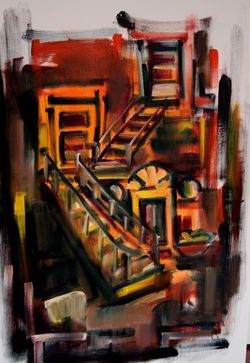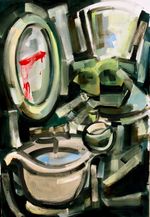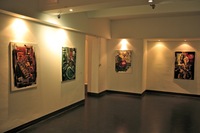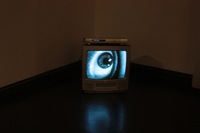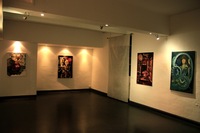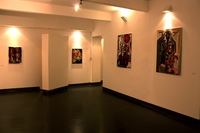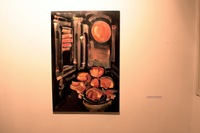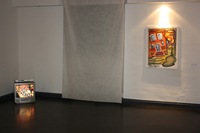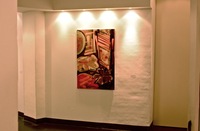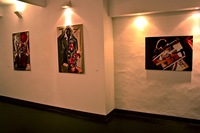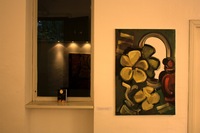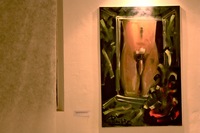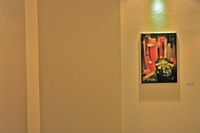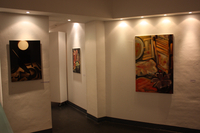NEW YORK INTERIORS
Pictorial, photographic and cinematic perspectives of Pietro Reviglio
A critical essay by Roberto Mastroianni
From the logic of the scientific discovery to the logic of the artistic discovery.
"Astonishment" and "wonder" generate knowledge: they are feelings, emotions, passions that lead human beings to research, presiding over their organized cognitive knowledge like two tutelary deities since the times of Plato and Aristotle. The two philosophers were the first to recognize in these two moods the force that leads us to philosophical interrogation and, subsequently, to scientific research. Such realization marked the beginning of the history of Western thought and contemporary sciences. Classical philosophy provided us with an investigation of reality rooted in the astonishment for reality and for the laws governing the way it functions and transforms: "wonder" is a feeling that generates questions on "why" and "how" things happen and, at the same time, an emotion coming from finding answers to such questions. "Astonishment", on the other hand, is the feeling that the "human animal" experiences when reality poses questions and we find answers capable of putting order in the exterior and interior chaos. At the same time, it is the feeling that human beings experience when they discover that the apparent nonsense of reality has meaning and significance and there is a logic which leads, organizes and moves reality.
"Astonishment" and "wonder" are only one side of the coin nonetheless: on the other side we find "disquiet" and "anguish". The hard work of living is confined inside the horizon delimited by these opposite feelings and consists in giving sense and significance to the nonsense of reality by means of structured narratives.
The sciences, just like the arts, try to find meaning and significance in every thing that exists inside and outside us. The logic of the scientific and philosophical discovery (the observation and the narration of the laws presiding over the human and non-human reality) and the logic of art and technical disciplines (which shape this reality by representing and transforming it) seem to be at odds, but they are instead complementary, because they both deal with the dark depths of anguish and disquiet hidden behind astonishment and wonder. Some artists realize, consciously or unconsciously, that science and art are human practices sharing greater similarities than it seems at a first sight and, with their work, they try to connect knowledge with expression and analytical observation with production of emotional narrativity. Pietro Reviglio is among them: he is a man of science (an astrophysicist) but he is at the same time an artist. For this reason he is capable of combining the eye of the researcher with the eye of the creator.
To be precise Reviglio was an astrophysicist who conducted experimental research on galaxies and the large-scale structures of the universe at Columbia University (New York). One day he found on his path the Art Students League of New York and there, in Robert Cenedella's and Mary Beth McKenzie's classes, he discovered that disquiet and anguish - the dark side of astonishment and wonder - could find answers in painting. At that point the scientist became an artist.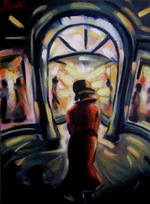 Lady in Orange (2006)
Lady in Orange (2006)
From Grotz's pupil (Cenedella) he absorbed a post-expressionist poetic of German origin that he bent to the needs of an eye accustomed to scientific research. From this life-changing experience it stemmed an artistic practice characterized by the "regime of sight". Sight, the most philosophical and scientific of the five senses with the eye that investigates the laws of nature and the light cuts that go through reality, becomes the sense by which the artist faces reality in search of results that only the "logic of the artistic discovery" can offer.
The researcher's eye focuses its attention in order to identify the structural laws of the real and brings them to representation through a poetic and artistic process marked by experimental traits very similar to the process used by researchers in laboratories. Nothing gets cast away though, and art and science, apparently so diverse, find themselves united under the eye of the artist-scientist. 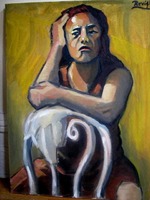 Seated Woman in Yellow Room (2006) The data coming from the "raw thingness" that the physicist used to observe and organize to deduce general theories capable of explaining reality and its laws are now observed in such a way that their natural organization leads to a general representation of the visible and the invisible.
Seated Woman in Yellow Room (2006) The data coming from the "raw thingness" that the physicist used to observe and organize to deduce general theories capable of explaining reality and its laws are now observed in such a way that their natural organization leads to a general representation of the visible and the invisible.
Astonishment and wonder pose questions and art finds answers and at that boundary where science is no longer adequate to provide answers, Reviglio switches from being a researcher to being an artist. For this reason, the art of Reviglio can be defined, in a way, experimental if for experimental we mean the use of an inductive practice that becomes a regime of sight and the artistic production. The cards of his new adventure are all on the table and now we just have to wait to understand where the new game will lead the artist-scientist. A new story begins here, we have to wait and see what outcome it will produce by combining "logic of the scientific discovery" and "logic of the artistic discovery".
The New York period: from the New York Paintings to the Nocturnal Visions.
In the womb of the (rotten) Big Apple, a New York at the beginning of the new millennium, the young scientist found himself in front of an easel, in an art school characterized by informality and equality in the relationship between instructors and pupils. There was certainly a sense of unsettlement and lack in that boy who used to observe galaxies: a sense of lack that turned into desire and a desire perceived as a sense of lack. The rigor of the experimental science used to put order in the external world, but the internal one was still in turmoil and only the empty canvas allowed him to identify and transform chaos and disquiet. He discovered that colors, points, lines, surfaces could shape up and lead to a result (the artwork) similar to the result of an experiment carried out in a laboratory.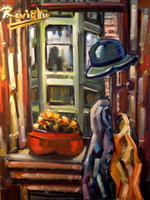 Voyeurism: My Room (2007) Accustomed to the wonder of the "logic of the scientific discovery", Pietro Reviglio found a new kind of logic: the logic of artistic discovery, something that he could explore in a different kind of laboratory - his artist studio and the spaces in which he spent his life at that time, the metropolis where he was living. All the lasting elements and characteristic traits of Reviglio's poetics and expressive style could be identified in his early works and in the intellectual gesture of transposing a scientific eye into an artistic practice, a leitmotif which will be present through his whole body of work.
Voyeurism: My Room (2007) Accustomed to the wonder of the "logic of the scientific discovery", Pietro Reviglio found a new kind of logic: the logic of artistic discovery, something that he could explore in a different kind of laboratory - his artist studio and the spaces in which he spent his life at that time, the metropolis where he was living. All the lasting elements and characteristic traits of Reviglio's poetics and expressive style could be identified in his early works and in the intellectual gesture of transposing a scientific eye into an artistic practice, a leitmotif which will be present through his whole body of work.
The elements that make Pietro an artist/scientist can be all ascribed to the "regime of sight": his physicist's eye allows him to put together common and scattered elements in a way that the inductive and logico-deductive procedure leads to a meaningful figuration; by means of his eye, which he once used for the analysis of light and physical phenomena, he now brings the pictorial and photo-realistic representation to a crisis by showing the force lines that delimit and structure the real; and sight allows volumes, dimensions, depths, internal and external spaces to be experienced. The eye investigates reality, penetrates the visible and tries to give sense to the invisible surrounding it.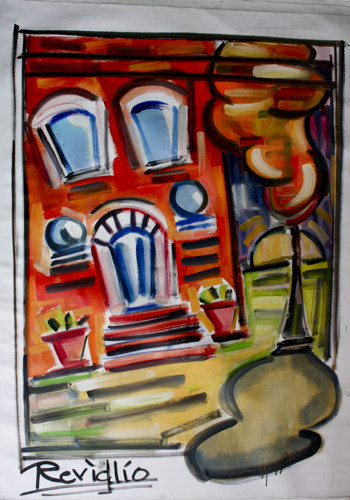 Orange House (2007)
Orange House (2007)
In this way, starting from a figurative obsession typical of the autodidacts, elements of his daily life began to fill his paintings - sparse, apparently common and banal objects that may be found in the room of any young man in his thirties in an American megalopolis. This gave birth to a first pictorial cycle "The New York Paintings" (2005-2009).
The eye of the researcher who becomes an artist begins to investigate the surrounding world in which deeply disquieting presences come to life. Presences that peculiar to him but at the same time plural because they are human phenomena. The city sights, the rooms where people can rest, study, live, the scattered objects (books, light bulbs), the street corners, the friends who become involuntary models: these are all elements that Reviglio finds in front of his eyes and investigates with a researcher's eye, surprised that all these elements slot in almost involuntarily according to their own logic, bringing out representation. This is the moment of the discovery of a logic intrinsic to the representation itself that becomes apparent in his artworks in a coherent way. This is the moment when the artist can say "I do nothing. I look and paint, but in the end the painting comes to life by itself as in a scientific experiment. I understand what I have painted only at the end. In the beginning I just put together the elements that I see around me and I try to understand how they can interact".
The interior and the exterior reality knocks at the artist's door and wants be expressed and represented. 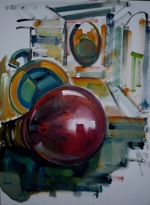 Red Bulb (2009) This is the phase of paintings like "Orange House" (2007), "Maureen" (2009), "Red Bulb" (2009), "Voyeurism: My Window" (2007) - paintings in which figuration is an objective to achieve anxiously, in search of shapes that render the visible and the invisible of reality.
Red Bulb (2009) This is the phase of paintings like "Orange House" (2007), "Maureen" (2009), "Red Bulb" (2009), "Voyeurism: My Window" (2007) - paintings in which figuration is an objective to achieve anxiously, in search of shapes that render the visible and the invisible of reality.
Little by little the disquiet takes over and the figuration comes to a crisis: the thicker brushstrokes, the colors and the emotions become stronger, the lines become more free and the post-expressionism of the Arts Students League period is overcome for themes and a style clearly individual. The turning point is "Maureen" (2009), where a personal style is achieved. In this painting the human figure stands out giving her back to a mirror and the interior landscape of the artist reconnects with the interior of his New York rooms which, up to that point, were represented through details and objects. In this painting the face of the woman (and her specific identity) disappears into an oval thus acquiring a generality, a universality, capable of embodying the human disquiet in relation to the feminine and the intersubjectivity created by a continuous interrogation.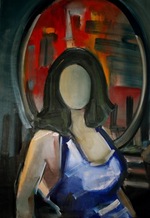 Maureen (2009)
Maureen (2009)
This is the dividing line between the "New York Paintings" and the "Nocturnal Visions" (2009-2011), the new series that Reviglio begins in the United States and continues in Italy in which the figuration tends to disappear and city sights, buildings, architectural and urban elements, people and common objects become part of mental scenarios increasingly restricted and claustrophobic. The New York interiors become mental sceneries in which the architectural elements suggest a mirror game between interiority and exteriority and the disquiet shapes up as a complex living experience of the anthropic space in a metaphoric and metonymic way. This is the case of an emblematic picture of this period entitled "10.57 p.m." (2010). In this painting the forms of the architectural spaces, the boundaries and the colors blur, confining space and sight. The protagonist is a staircase connecting several, perhaps contradictory, mental rooms with doors rigorously closed, across which our eye is forced to move, claimbing steps of strong chromatic intensity. 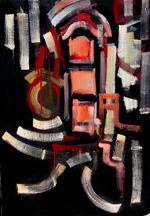 4.31 a.m. (2011)The "New York Interiors" of Reviglio acquire in this way their peculiar nocturnal trait (the diurnal dimension of his earlier cycle of paintings is completely surpassed and "Maureen" was the turning point): the mental rooms are rooms in which the night brings anxiety and disquiet and the shapes blur into powerful and almost abstract brushstrokes of color as in "4.31 a.m." (2011). In these rooms common objects (a sink, a mirror, a lamp) represent an ultimate sign of awkwardness, drives, anxieties. They are boundaries that confine the world of the artist and his interior turmoil as in "1.37 a.m." (2010) or in "6.04 a.m." (2011).
4.31 a.m. (2011)The "New York Interiors" of Reviglio acquire in this way their peculiar nocturnal trait (the diurnal dimension of his earlier cycle of paintings is completely surpassed and "Maureen" was the turning point): the mental rooms are rooms in which the night brings anxiety and disquiet and the shapes blur into powerful and almost abstract brushstrokes of color as in "4.31 a.m." (2011). In these rooms common objects (a sink, a mirror, a lamp) represent an ultimate sign of awkwardness, drives, anxieties. They are boundaries that confine the world of the artist and his interior turmoil as in "1.37 a.m." (2010) or in "6.04 a.m." (2011).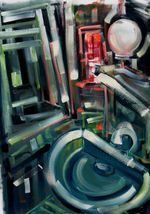 1.37 a.m. (2010)
1.37 a.m. (2010)
The New York phase gives us some elements that will become constant in the poetic of Reviglio: a certain presence/absence of the feminine, a thick, textured brushstroke, the light as a delimiting element, phallic forms that appear through his representations and common objects that become part of his oneiric narrative.
Cinematography of Urban Madness
In the last years of the New York phase, the interiors become more and more the scenery of dirty and disquieting relationships reminiscent of a noir scenography. Nocturnal is the dimension of Reviglio's figuration, nocturnal the passions and the drives that he stages but, in some way, the colors exorcise and manifest a complexity of emotions that make the rooms the counterpart of the urban madness. An insanity that remains locked out of the door, while the life inside goes on in search of the self, oscillating between the diurnal and the nocturnal vision of an existential space that can surface only through colors, light and shapes. 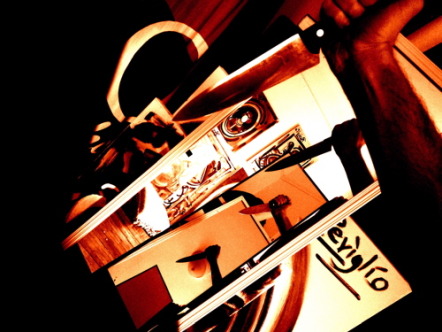 Cinematography of Urban Madness #8 (2009)
Cinematography of Urban Madness #8 (2009)
The New York interiors are murder scenes in which the artist takes disquiet and nonsense to make recognizable and meaningful shapes emerge. At the same time they are the laboratory of the artist-scientist, who uses light and color to carry out his pictorial experiments in such a way that lack and desire acquire the shape of an organized and meaningful narrative. If inside the rooms there are disquiet and artistic experiments, outside there is madness and violence which also need to be represented. It then begins another experiment that brings the eye to confront itself with photo- and video-realism.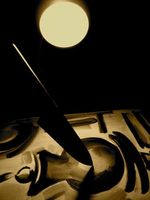 Cinematography of Urban Madness #6 (2009)
Cinematography of Urban Madness #6 (2009)
When Reviglio came back to Italy after the years spent in the United States, most of the art world attention concentrated on his photographic work and videos which were created, for the most part, during this period of transition in his poetics and living quarters. New York is an odd and violent city in which madness becomes a constant in the urban landscape, a spreading social and mental malaise which becomes an element of common perception and from which Reviglio cannot hide. The uneasiness, the insanity, the violence call for his attention and it begins a period of photographic and video experimentation (2009-2012) in which the eye of the artist focuses on the urban context and the relationships that it builds. This transition begins when the interior and the exterior sceneries join. The main character of the artistic operation is still the eye which must realize, before investigating the external world, that the same light that it has investigated through the paradigm of science till then, not only allows painting to manifest but in some way delimits the work themselves and the perception of objects even before their representation. The private rooms become the scene of a murder and Reviglio begins to kill his own paintings in a performing practice that closes once and for all his New York period. The paintings are there in his studio with their extreme figuration and the following crisis of figuration. Now the disquieting thoughts which have materialized and pushed him towards the external world, bring Reviglio to develop a photographic project in which paintings are photographed or filmed as he cuts them and murders them with a knife.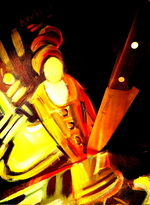 Murder of a Painting (2009)
Murder of a Painting (2009)
The images of his paintings (used in their integrity or in pieces) and the images of parts of the artist's body, a knife as in Psycho, the performance first photographed ( e.g. Murder of a Painting, 2009 - Cinematography of Urban Madness 2009 - Nocturnal Interior, 2010) and then assembled in a video (Cinematography of Urban Madness, 2010, 4.14 min.) bring out the psychoanalytic baggage in Reviglio's work and his preference for a cinematographic aesthetics a la Hitchcock.
By saying this, we are not trying to banalize the artist's videos, on the contrary we want to identify a research line that following light, which delimits space and determines the shapes of the artworks, now reaches an extreme by bringing to awareness the sexual and psychoanalytic tension in Reviglio's works. A research that would develop into an investigation on human relationships and urban spaces and not just interiors.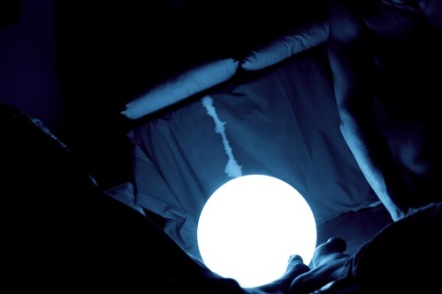 Nocturnal Interior (2010)The subsequent videos (The Oval Mirror, 2011 - The Window Over the Sky, 2011 - Nocturnal Visions 2012 ) appear as a synthesis between painting, photography and kinematics and try to piece together the scattered elements of his work thus giving a final shape to interiors and exteriors that are mental sceneries in which existence, with its drives, anxiety and beauty gets a shape.
Nocturnal Interior (2010)The subsequent videos (The Oval Mirror, 2011 - The Window Over the Sky, 2011 - Nocturnal Visions 2012 ) appear as a synthesis between painting, photography and kinematics and try to piece together the scattered elements of his work thus giving a final shape to interiors and exteriors that are mental sceneries in which existence, with its drives, anxiety and beauty gets a shape.
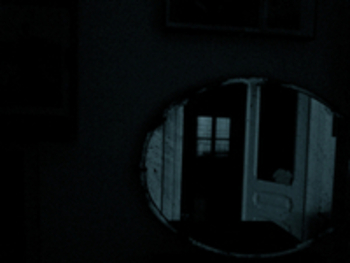 video still from "The Oval Mirror" (2011)
video still from "The Oval Mirror" (2011)
Flowers of Grief
Reviglio would have probably quit painting if he had listened to his Italian gallerists. Instead, some artist friends, an art critic and the brutality of reality convinced him to continue his painting practice after moving back to Italy, thus completing the exploration of the Nocturnal Visions (the artist still divides himself between Turin and New York).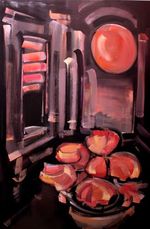 Cancer: Black Room with Orange Sun (2012)The return to Italy was a quick change of interiors and exteriors, the mental sceneries of his private rooms and his "public rooms" needed new shapes, but all of a sudden everything became more complicated: "the alien" (cancer) had crept inside the life of people close to him changing completely the times, spaces, moods of his life, and bringing a new form of disquiet more powerful and dramatic than the existential one experienced in New York. Photography and videos had marked a moment of synthesis and sharpened the tools of his art laboratory and at this point the logic of the artistic discovery pushed him to investigate that living thing that grows inside people close to you, people you share private and affective spaces with. It begins in this way a new pictorial cycle accompanied by photos and videos, entitled "Flowers of Grief ", a series that presents interiors with stronger colors, often darker and violent, in which the brushstrokes become bolder and the oil paintings begin a dialogue with the photographs and the videos in search of a presence, of something alive that grows in between people and animates in a mysterious way the private rooms. The metamorphic and vital power of the "alien" becomes manifest in his work and flowers appear in the composition. They are flowers of evil and grief, which grow spontaneously near the objects of common usage that, up to that point, confined the boundaries and the qualities of the existential spaces represented. A shirt stands out against a painting background as if it were a faceless man without his hands (Torn Shirt, 2012), portraits of faceless women are surrounded by plants and flowers that set the chromatic dominant of the art works, colors become warmer to better represent the emotional tone of someone who cares for his beloved ones and at the same time must live with "the alien".
Cancer: Black Room with Orange Sun (2012)The return to Italy was a quick change of interiors and exteriors, the mental sceneries of his private rooms and his "public rooms" needed new shapes, but all of a sudden everything became more complicated: "the alien" (cancer) had crept inside the life of people close to him changing completely the times, spaces, moods of his life, and bringing a new form of disquiet more powerful and dramatic than the existential one experienced in New York. Photography and videos had marked a moment of synthesis and sharpened the tools of his art laboratory and at this point the logic of the artistic discovery pushed him to investigate that living thing that grows inside people close to you, people you share private and affective spaces with. It begins in this way a new pictorial cycle accompanied by photos and videos, entitled "Flowers of Grief ", a series that presents interiors with stronger colors, often darker and violent, in which the brushstrokes become bolder and the oil paintings begin a dialogue with the photographs and the videos in search of a presence, of something alive that grows in between people and animates in a mysterious way the private rooms. The metamorphic and vital power of the "alien" becomes manifest in his work and flowers appear in the composition. They are flowers of evil and grief, which grow spontaneously near the objects of common usage that, up to that point, confined the boundaries and the qualities of the existential spaces represented. A shirt stands out against a painting background as if it were a faceless man without his hands (Torn Shirt, 2012), portraits of faceless women are surrounded by plants and flowers that set the chromatic dominant of the art works, colors become warmer to better represent the emotional tone of someone who cares for his beloved ones and at the same time must live with "the alien".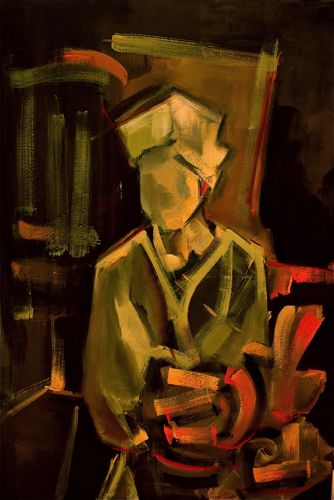 Woman with Cancer (Flowers of Grief, 2012)
Woman with Cancer (Flowers of Grief, 2012)
One way or the other, Reviglio remains an artist-scientist and begins to experiment compositions of interiors that are mental sceneries well-aware that in the end, as in scientific experiments, the result will spontaneously surface and it will be a well-structured narrative with sense and significance able to account for the human existence between wonder and disquiet.
Roberto Mastroianni
Turin, spring 2013
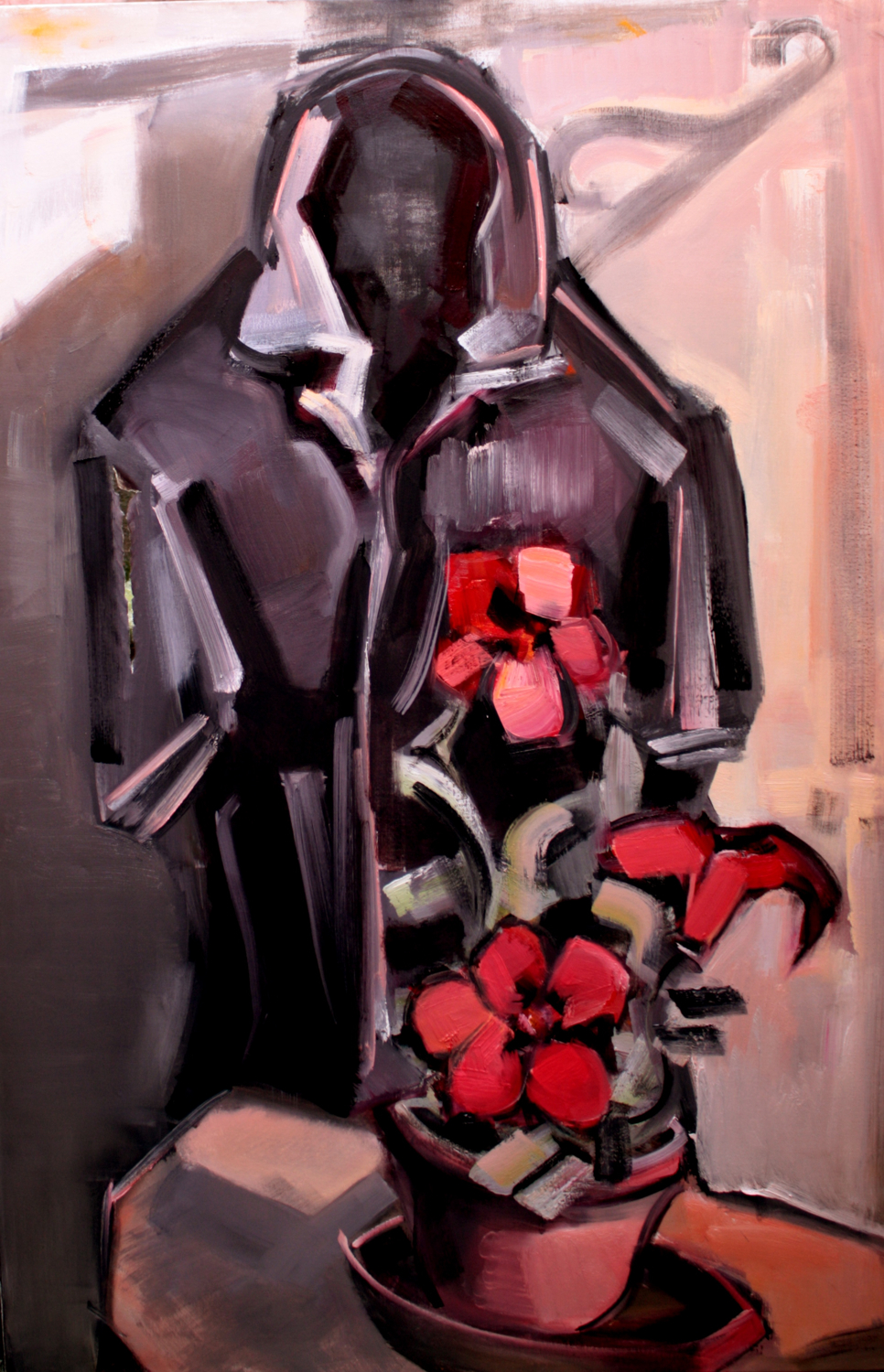 Torn Shirt (Flowers of Grief, 2012)
Torn Shirt (Flowers of Grief, 2012)
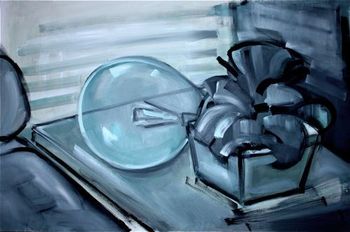 The Blue Room (Flowers of Grief, 2012)
The Blue Room (Flowers of Grief, 2012)
Born in Turin in 1976, Pietro Reviglio has exhibited in the United States, in Italy, in Japan and in the United Kindom. He studied painting at the Arts Students League of New York with Mary Beth McKenzie and Robert Cenedella and Animation at the School of Visual Arts. He received a Ph.D. in Astrophysics from the Graduate School of Arts and Sciences of Columbia University (New York). Among his recent shows: Castel dell'Ovo (Naples), Palazzo Ducale (Genoa), Museo Laboratorio d'Arte Contemporanea (Rome), Palazzo Farnese (French Embassy, Rome), the 54th Venice Biennial, Columbia University (New York), the Museum of Oriental Art (Turin) and the Ishida Taisheisha Hall in Kyoto. Articles on his work have appeared on Flash ARt, NY Arts, La Stampa, La Repubblica, America24, Yahoo News.
Roberto Mastroianni is a philosopher, curator and art critic and an independent researcher in semiotics, philosophical aesthetics and language philosophy at the University of Turin. He studied philosophy with Gianni Vattimo and Roberto Salizzoni at the University of Turin where he received his Ph.D. in Language Philosophy and Communication Studies under the supervision of Ugo Volli. He works on language philosophy, philosophical aesthetics, semiotics, general theory of politics and communications. He curated and published books, essays and articles on philosophy, art, communication and politics. He curated several contemporary art exhibitions in museums including Palazzo Ducale (Genova) and lectured in several universities in Italy and abroad.
NEW YORK INTERIORS
Fusion Art Gallery, Torino. Through April 6, 2013.
